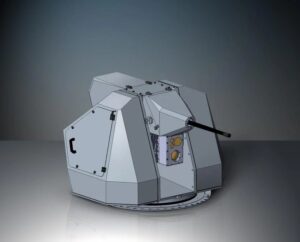According to a communiqué from the Italian aerospace and defence company Leonardo, the LIONFISH Top artillery system has been selected as the small-calibre weapon for the German Navy's future F126 frigate class. LIONFISH Top is the variant of Leonardo's 12.7mm weapon system, whose gun armour meets high stealth requirements.

Self-defence system
The remote-controlled weapon system has electro-optical target detection and tracking, consisting of a daylight camera (detection up to 9.5 kilometres), an infrared camera (detection range up to 12 kilometres) and a laser rangefinder (tracking from 5.5 kilometres). The cadence of the weapon is a maximum of 400 shots per minute, with a maximum range of 1,500 metres. The entire system - without ammunition - should weigh less than 300 kilograms.

It is not clear from Leonardo's press release how many LIONFISH topside systems have been ordered. Leonardo merely states that the company has been asked to equip four frigates, including two optional units. According to a model of the F126 exhibited by DAMEN Naval at SMM, the frigate will have four such small-calibre weapon systems for close and short-range engagement - two in the forward section of the ship and two on the hangar. Further details are currently not available. Note: Back in November 2022, it was announced that Rheinmetall had been commissioned to supply eight MLGs for the F126.
Leonardo is therefore equipping the future frigates with two artillery weapon systems. In March 2022, the the provision of the OTO 127/64 LightWeight (LW) Vulcano.
The F125 frigates of the Baden-Württemberg class are each equipped with five remote-controlled Hitrole artillery weapon systems of the same 12.7mm calibre (Highly Integrated Turret, Remotely Operated, Light Electrical). The naval weapon system developed by Oto Melara is also used in the Netherlands on the Holland-class OPV and the multi-purpose supply ship (Joint Logistic Support Ship) "Karel Doorman".









4 responses
On all published graphics and pictures of the F126 known to me, the 12.7 mm and 27 mm guns were difficult to distinguish. In my opinion, your pictures show a 12.7 mm gun (starboard) and a 27 mm gun (port; possibly naval light gun MLG) next to the RAM launcher on the hangar. Also next to the heavy 127 mm gun (starboard: possibly MLG).
Unless I have overlooked something, this results in a total of two 27 mm guns and two 12.7 mm guns (and not four 12.7 mm guns) per ship.
The significantly different and asymmetrical arrangement compared to the F125 as well as the much smaller number of guns is not yet clear to me (F125: five remote-controlled 12.7 mm guns and two 27 mm guns). Also, it seems to me that the 12.7 mm guns could only be operated right up to the side of the ship on the F125, but not on the F126.
Hello, Mr Steinheuer.
Thank you for your comments.
I admit, I don't really know exactly how it should be.
And I don't get any details from Koblenz or Hamburg (Damen Naval Germany).
Furthermore, you are absolutely right: my pictures show the positions of the MLG. By the way, eight MLG were ordered (according to Rheinmetall). They would then be positioned according to the pictures - my Giss.
I will make the changes to the article.
Two 27 mm Sea Snake MLG from Rheinmetall and two 12.7 mm LIONFISH can be seen on the ladies' model. At the bow and stern one 27 mm and one 12.7 mm. A total of eight LIONFISHs are expected to be ordered from Leonardo.
Hello, Mr Spe.
Thank you for your comments.
I admit, I don't really know exactly how it should be.
And I don't get any details from Koblenz or Hamburg (Damen Naval Germany).
Thank you for your comment.
By the way, eight MLGs have been ordered (according to Rheinmetall). They would then be positioned according to the pictures - my Giss.
I will make the changes to the article.
H. Uwe Mergener